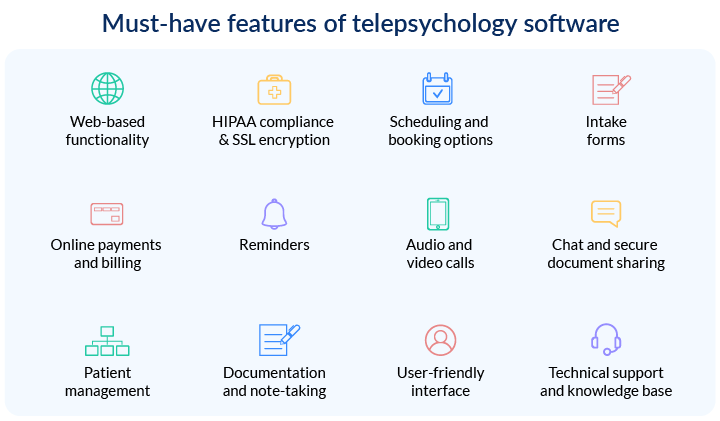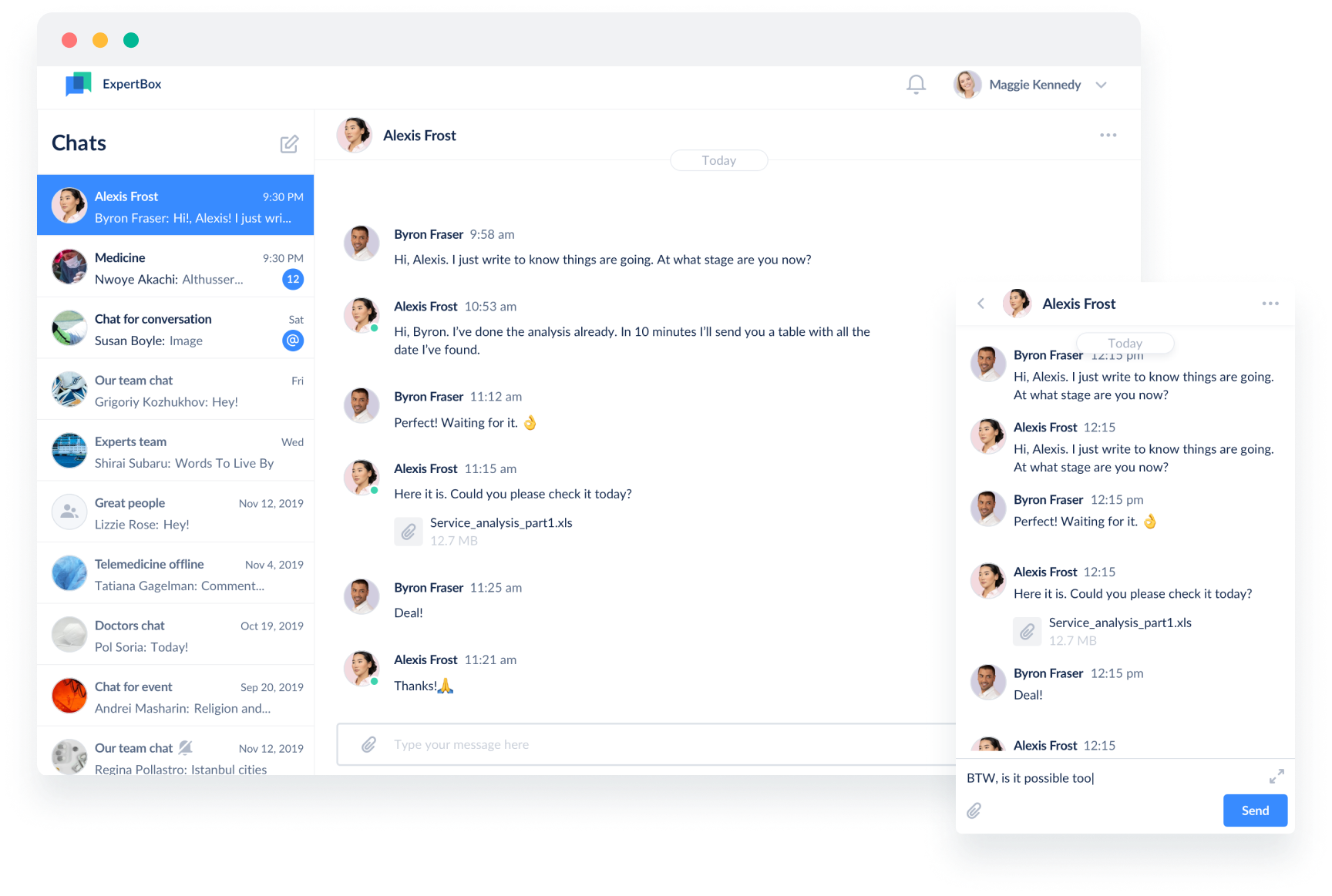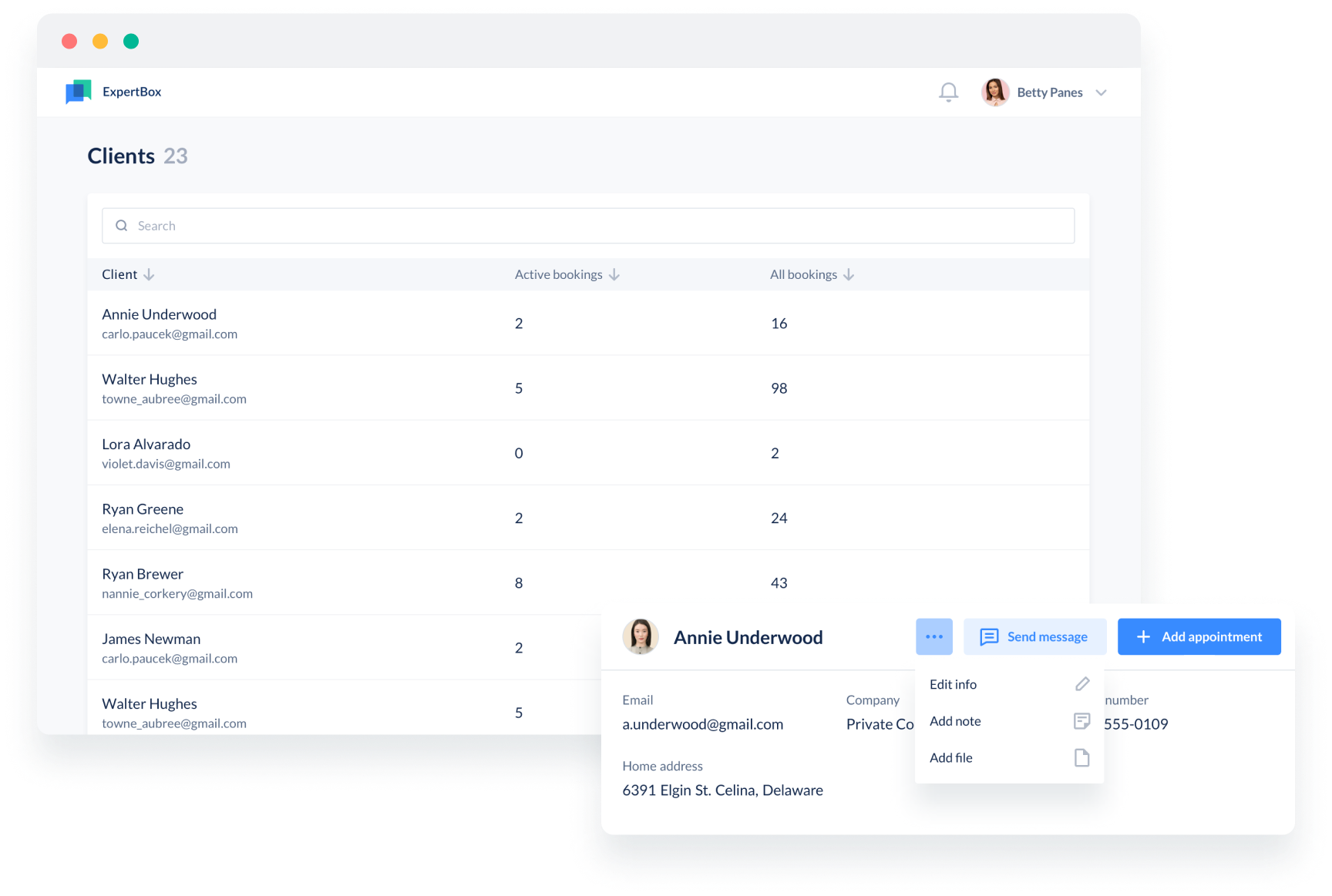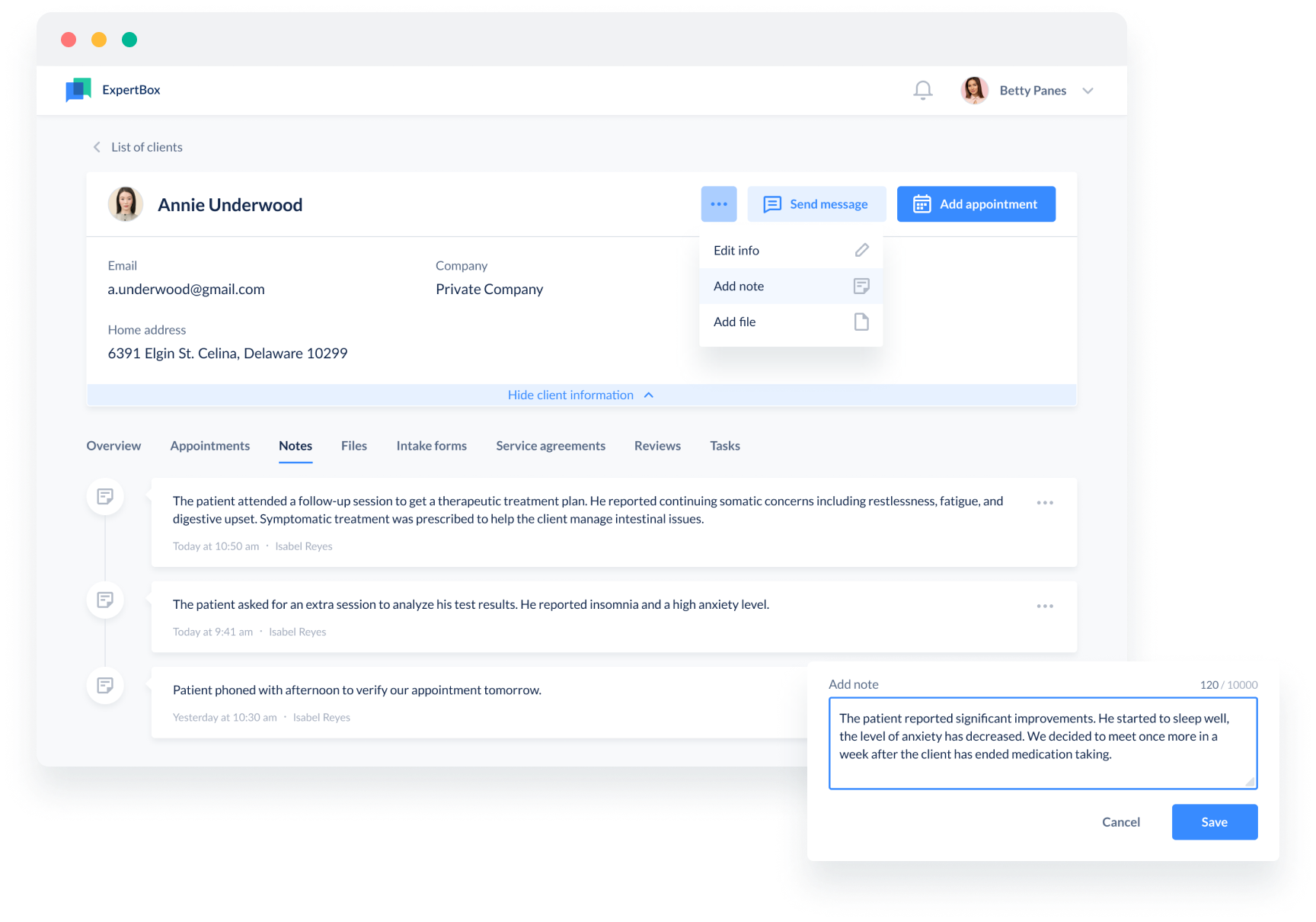Have you ever wondered how many therapists rely on teletherapy tools to provide their services? The number of specialists who have adopted telehealth has grown from 33% in 2020 to 50% in 2021. With the increasing demand for telehealth, the teletherapy tools market now offers versatile options so even practitioners previously committed to traditional in-person consulting became interested in trying them out.
If you’re new to teletherapy, learn more about it before implementing it into your practice.
What is telepsychology software?
First, it’s important to understand what falls under the definition of teletherapy tools.
Teletherapy is a process during which therapists provide their services to patients by means of telemedicine, using any remote communication methods that fit the practice and its purposes.
The solutions and platforms used to offer virtual services have to be secure, prevent any sensitive data breaches, and give practitioners access to an extensive range of functionality that allows consulting patients online and simplifies the general workflow.
Some features are more important than the others, some can be considered optional, but that is a decision specific to your practice. Let’s explore the features that will come in handy for holding online therapy sessions.
Must-have teletherapy features
Teletherapy has been widely used for years, so it’s not surprising that nowadays teletherapy software can offer not only secure video calls but also a whole set of features aimed at taking the burden of practice management off your shoulders.

1. Web app / browser-based app
Whenever you access your schedule, check your appointments, chat with a patient, or hold a video call, it shouldn’t take any extra effort. That’s why you should pay attention to web applications that provide sufficient functionality from any device and require only a reliable Internet connection. You won’t have to look for patient records stored in a local database somewhere in your office. All the data will be at your fingertips.
2. Security
You might ask yourself if it’s secure to keep all the sensitive health records online, being aware of the consequences of HIPAA noncompliance and the penalties healthcare practitioners get whenever they expose ePHI to third parties.
Indeed, every healthcare practitioner must comply with HIPAA standards, and this includes therapists. As of last year, the penalties for secured data breaches have reached a total of $5,982,150, so no wonder HIPAA has become one of practicing clinicians’ biggest concerns.

You might not know the data security standards by heart, but the software you use has to be HIPAA-compliant. Usually you can find compliance standards information on the software’s webpage. You should also check if:
- the creators acknowledge that the solution is HIPAA-compliant
- there’s an option for a Business Associate Agreement
- there’s a Privacy Policy that defines how the data is collected, stored, and shared
- there are data encryption methods used
This will help you determine if the software you’ve chosen is fit for teletherapy.
Learn more about HIPAA compliance in therapy billing from an article dedicate to choosing HIPAA-compliant billing solutions and bill your patients online!
3. Scheduling and booking
60% of patients prefer online booking to other methods because it allows them to book immediately. Usually online scheduling doesn’t require any extra steps, so you definitely should look for this feature in teletherapy practice management tools.
Also check if it allows rescheduling at the patient’s request and adjusts for different time zones. Ideally, the booking list should be also filterable so you can quickly access specific time slots or patients’ appointments.

Some of the booking solutions might also let your patients join the waitlist if there are no empty time slots available. This feature notifies the patient whenever there is a free slot, while the waitlist function makes sure you won’t lose prospects even when you’re fully booked.
4. Intake forms
Once the appointment is booked, a specialist has to prepare for the consultation. This includes understanding the goals and objectives of the consultation as well as the patients’ expectations and their current situation. Have your patients fill out an intake form when they book an appointment to make your online sessions more efficient.

This feature is important for practitioners and patients. It allows patients to ask questions before the actual online consultation and you as a specialist to receive all the patient information you need.
Shared files should be protected as well because, even at this stage, your patients might send you secure data, including previous healthcare records or prescriptions.
5. Online payments and billing
When it comes to money, many practitioners who start out providing online services face the unpleasant fact of not getting paid because of no-shows. It can also be difficult to collect all your income information for tax purposes because of refunds and other payment adjustments.

That’s why it’s absolutely necessary to see if the teletherapy tools you’re looking at offer automated refund options and keep detailed payment history so you can sort taxable and non-taxable income as well as claim any possible deductions.
6. Reminders
An additional benefit of teletherapy tools is the reminders option. It will notify you and your patients about the approaching consultation time to effectively reduce the no-show rate and help you manage your time.

The appointment notifications are usually connected to a calendar or sent via email. These settings can usually be adjusted to ensure that patients won’t be spammed with multiple messages.
7. Audio and video calls
The cornerstone of any teletherapy practice is the actual consultation, and it is undeniable that its success mostly depends on the specialist’s skill. However, no matter how professional and prepared you are, you still might face:
- transmitted data insecurity
- video calls platform unreliability
- poor video call quality
- inability to share additional data or to use the chat function
It is important to ensure your teletherapy tools offer quality video and audio calls.

There are multiple ways to make the video communication between a therapist and their patient more effective and comfortable for both parties:
- Personal meeting rooms. Personal meeting rooms can be created prior to the consultation and patients can join once the physician is connected. Some software also provides appointment lobby options so physicians can admit patients to the session when they are ready
- One-on-one high-quality video calls. Video calls should use an SSL encryption method and be available right from the web application so neither patient nor specialist have to download or install anything prior to the session
- Group calls. Group calls are a must-have feature for family consultations and team trainings
- Secure file sharing options. Secure file sharing options will help you share useful materials and checklists with your patients to provide during the session
- Screen sharing. Another option that can take your consultations up a notch is screen sharing. Whenever you need to present information to your patient, you can easily share your screen, boosting your practice with visual content
- Recording. Some software will let you record online sessions and save them in the secure cloud. This feature will help you work on further sessions and analyze initial results — just make sure the patient knows that your meeting is recorded. You will also be able to access and delete these recordings as well as provide them to your patient at any time
Whether the solution you choose will have all these features is up to you. However, we recommend that you focus on choosing teletherapy tools that are convenient both for you and your patients and is reliable in terms of quality and security.
8. Chat and secure document sharing
Chat functionality differs from solution to solution, but there are some features that are particularly important:
- one-on-one and group chat options
- filterable chat history
- ability to manage chats and shared files
- security
Maintaining the connection between you and your patient between sessions is as important as the session itself, so prioritize teletherapy tools that provide a stable secure chat.

Ideally, your patient should be able to reach out to you via chat using their account that is safe from third-party access in case they have any questions.
9. Patient management
Though some practitioners keep patient data in Google sheets or Excel, teletherapy tools can provide you with more efficient alternatives.
Besides the video call and chat options, teletherapy tools often include:
- sortable and searchable patient lists
- appointment history
- custom fields to store practice-specific data
- options to create custom fields

The in-built solutions are definitely worth exploring, as they not only keep all the data synched and updated at all times, but also meet security standards. Another huge benefit of using all-in-one teletherapy tools is that it’s much easier to access data when it’s kept in one database.
10. Documentation and note-taking
Documentation is the heart of any practice: therapists use agreements, terms, and policies to inform patients about the services they provide.

That’s why it’s always a good idea to check if the software you intend to use provides you with a customizable Terms of Use and Privacy Policy and lets you create and share legal agreements.
Some teletherapy tools also include the ability to take notes during the sessions and connect them to the patient’s profile. These notes can make a huge difference by improving the communication process and making sure you don’t forget any important details.

With the right software you’ll be able to add your session summaries, store them, and access them later while you prepare for a follow-up consultation.
11. User-friendly interface
It’s easy to underestimate the power of an easy-to-use interface, but it still makes a huge difference in the long run. According to Toptal, 90% of users won’t return to a solution solely due to bad UX. Even if you have undisputable professionalism, you still can lose a patient because of a platform that is difficult to understand and use.

Before you choose an application or software, make sure it simplifies your patients’ experience. There shouldn’t be too many steps of onboarding, and the platform should be easy to access.
12. Technical support and knowledge base
No matter how reliable and professional your chosen solution might seem, you have to be prepared for emergency situations. No one can guarantee the stability of the application after updates, and server downtime happens even to top enterprises like Amazon and Google. You have to feel confident that the solution’s support team will assist you if anything goes wrong.
Before making a final decision on which tools to use, enquire if you will be eligible for support. Also take some time to read and familiarize yourself with the knowledge base.
What to consider when choosing teletherapy tools
Psychologists and therapists that are new to telemedicine, are looking for solutions that best fit their practice and benefit their patients. How do they decide which teletherapy software is best, and what impacts their decision the most?
Needs and goals
When it comes to telepsychology, every therapist has their own set of methods and strategies when organizing their patient workflow. That’s why there can’t be a universal software solution. Only you as a practitioner know which features you should concentrate on when picking a software.
You might want to pay more attention to patient experience and explore the solutions that gather feedback, or you may want to look for extended patient management options. In any case, the software you use has to meet your and your patients’ needs.
Price
A software that accommodates all the needs of a telepsychology-based practice can’t be free simply because it provides costly security features and needs support, regular maintenance, and to be regularly updated to function properly.
You can find the prices and features for the most popular software solutions as well as lucrative ones in the table below — feel free to check them out.
| Features | Zoom for Healthcare | ExpertBox | Doxy.me | Simple Practice | Thera-link |
|---|---|---|---|---|---|
| HIPAA compliance | |||||
| HQ video calls | |||||
| Group calls | |||||
| Scheduling | |||||
| Booking | |||||
| Patient management | |||||
| Document management | |||||
| Secure file sharing | |||||
| Payment system integration | |||||
| Patient notes | |||||
| Price / month* | $200 | $29.95 | $35 | $44 | $45 |
As you can see, some of the solutions represented above are focused on providing video calls but don't offer patient management or file sharing features while others offer an all-in-one solution for a set price.
What’s more important, in some cases you can purchase additional features for an extra fee. Some software, however, simply doesn’t provide the specific functionality you need at all. That’s why you have to be certain that the solution you choose is not only affordable but also already has everything you might need for your practice. Otherwise, you’ll end up using different software for different purposes and potentially risking data losses.
Ease of use for patients and staff
One of the most common practices to determine the best tools for you is to apply the usability metrics method. It estimates factors such as:
- effectiveness
- efficiency
- satisfaction
In short, the solution shouldn’t have any bugs or issues or require much effort to work with.
Also it’s a good idea to collect patients’ feedback on the software and check its reviews before adopting it into your practice. Another option to test an application is to try it out. Many apps offer a trial period so you’d be able to register, check the functionality, and determine if it is the right fit for you.
Get online bookings and payments, manage patient information, and hold video calls in your browser. Sign up to see how ExpertBox can transform your workflow.
Customization
When you start providing consultations via telepsychology, you can’t predict the scalability of your business. However the bigger your business grows, the more you’ll need to adjust your workflows.
We recommend choosing an application that offers robust customization features tailored for therapy practice from the very start so you can immediately develop a workflow with any feature you might need.

Final thoughts
Building a successful online practice requires constant personal investment. At the same time you’ll be managing workflows and exploring the most beneficial methods for your practice. It is a process of constant learning because the success of your online consultations depends not only on your skill but also on the chosen tools.
Deep understanding of teletherapy software’s features has already become a key to success for many practitioners. Feel free to dive deeper and keep learning about how teletherapy tools can improve your consultations.
FAQ
-
Teletherapy tools include the solutions and platforms used by psychology practitioners to offer consulting through remote communication methods.
-
Teletherapy tools often provide practitioners with the following features:
- Security protocols and HIPAA compliance
- Scheduling and booking options
- Intake forms
- Online payment and billing options
- Reminders
- Audio and video calls
- A chat function
- Secure document sharing
- Patient management
- Note-taking and documentation
- A user-friendly interface
- Technical support and a strong knowledge base
They might differ from solution to solution.
-
In order to compare teletherapy tools pay attention to the following criteria:
- Needs and goals
- Price
- Usability
- Customization
- Technical support




